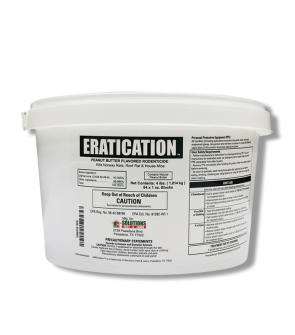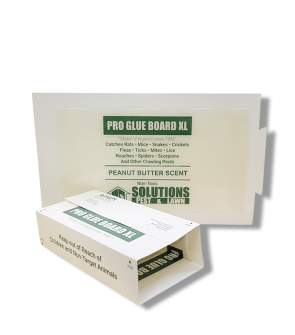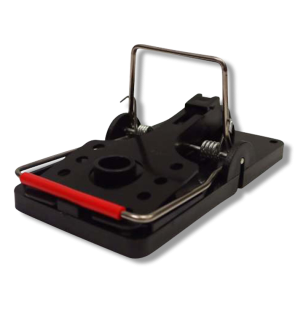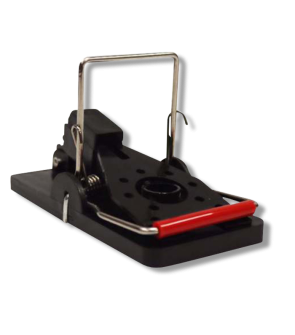Gain access to personalized product screening, the best pricing, rewards, and more!
Most Effective Products
How to Keep Rats and Mice Out of Your Garage
This page is a general guide to controlling rats and mice in garages. By using the recommended products and methods, you can control rats and mice in your home's garage. Follow this DIY guide and use the recommended products, and we guarantee 100% control of rats and mice within residential garages.
A rat or mouse problem in your home is a horrible experience, but it's just as bad if you spot them in the garage. In the garage, they will not only contaminate and damage your holiday décor, storage items, and pets' food but can also render your vehicle or other stored machinery useless.
Throughout the winter months, rodents will be drawn to enter your home - in this case - the garage to escape the cold and gnaw on food and wiring. Garages are ideal places for rats and mice to hide in due to toolboxes, children's toys, workbenches, and boxes. Even organized garages are prone to rodent infestations since these pests favor hiding within the walls to create their nests.
Whether you have rats or mice, getting rid of them can help give you peace of mind and save you in future homes and possible car repairs. Time is essential when controlling rodent infestations as each species can reproduce quickly and mature into sexually reproducing adults in as little as a year. While you may become overwhelmed with rodent activities, these pests can be controlled with the following products and steps suggested throughout this DIY guide.
Signs of Rats and Mice in Garages

There are a few ways to tell if a rat or mouse has made it home in your residential garage. In some scenarios, only a handful of rodent signs may be noticed, but there could be multiple indicators of rat or mouse infestation. When one or more of these signs are noticed, you will want to implement rodent control methods quickly.
Droppings: Fecal matter smaller than 1/4 inch is mouse droppings, and anything larger than this would be rats. House mice are the most common mouse species encountered in homeowners' garages. Similar to the shape and size of rice, house mouse droppings are dark to light brown in color and have a smooth appearance.
In contrast to mouse fecal matter, rat feces are larger in length and broader. Norway rats have blunt ends measuring 3/4 inches, and roof rats have pointed ends that range up to 1/2 inch in length. Rat droppings have a black coloration and, like mice, scatter their waste sporadically as they travel around the garage.
Gnawing: Scratch marks or holes left behind after a rat or mouse chews on something are often more easy to see. Rodents must chew on various materials to keep their front incisor teeth sharp and maintain their size. Materials often gnawed on in a garage are wall insulation, available wiring in walls, mowers, and cars, dog food bags, plastic bags or trash bags, bird and grass seeds, cardboard boxes, and the edges of furniture kept in garages.
Nests: A mouse or rat nest can be made from anything these invasive pests can find, such as shredded paper, cloth, fiber, leaves, grass, and other materials gnawed on by the rodent. Unlike bird nests, a rodent nest is bundled into a messy ball with no particular order of how materials are stacked. Rodent nests are often found in warm places like within the walls, behind appliances like a washing machine, inside of furniture, or idle machinery.
close to food sources and well hidden, such as inside wall spaces, behind appliances like a washing machine or furniture kept in the garage, and within the engines of unused machinery.
Foul Odors: Any strange smells that contain a foul, musky odor could indicate a rodent's deification and urine. Mice and rats often defecate prominently as they travel around your garage and across stored items.
Sounds: Listen for scratching sounds or light thumping, usually at night. Rodents are evasive creatures that are most active at night when there is less human activity. When listening for rat or mouse sounds, they may come from inside walls, under shelving and other objects, inside machinery, and storage containers.
How to Get Rid of Rats and Mice in Garage
Before moving forward with any form of rodent control, you must wear the proper personal protective equipment (PPE) to protect yourself against their waste and avoid leaving your scent on rodent control products.
It would be best to follow this plan at least several weeks before the weather becomes cooler in your region. Wait until the rodent infestation is controlled before implementing cleaning practices such as mopping, disinfection, or air fresheners, as this could deter them from visiting traps. If there are no rodents present, then this practice can be used.
Make Your Garage Less Desirable

The best way to discourage rats or mice from entering your garage is to make it as unattractive to them as possible. Once a rodent enters your garage, it does not take long for them to find their way into your home. Remember that this area provides numerous nesting and food sites, so you must ensure these conditions are removed.
Begin by storing any food items, such as dog or cat food, bird seed, grass seeds, and other powdery or food-related items, within sealable plastic containers. Other items stored in a cardboard box will also need to be placed in a tight-fitting plastic container. Even if the contents are not desirable for the rodent, they will still search for the cardboard box material since it can be used for nest creation or to sharpen their incisor teeth.
Keep your garage clean by removing piles of stored items and tossing away uneaten pet food in pet food bowls kept in the garage into an outdoor garbage container. Items touching the ground, stored against the wall, and stacked in piles allow the rodents to travel without being detected.
Place items on shelving to pull them away from the wall and off the ground. More exposed spaces in your garage will help lessen the pathways used by rodents to travel and discourage them from foraging.
If you keep firewood in the garage, it must be stored on shelving or outside, at least several feet away from your home's foundation.
Clean out your vehicle or any other stored machinery of any food and plant residues. Then, proceed with vacuuming and wiping off the dash, seats, steering wheel, floor, carpet, side of doors, and cupholders. You may also want to occasionally move the machinery or vehicle to deter rodents from making nests within the engine.
Seal Entry Points
Once your garage is cleaned, look around the perimeter of your home and seal any entry points you may find. Rats can fit through holes as small as a quarter, while mice can fit through holes as small as a dime. Be sure to keep your garage door and other doors leading to the inside of the home closed. Ensure they are properly sealed with no gaps or spaces around and beneath these door frames.
These entry points can usually be found around window, door, and garage frames, where plumbing meets the wall, on exterior and interior walls, at the bottom of a home's foundation, and in room corners. Block these entry points with caulk, and for larger voids that cannot be filled, use copper mesh. We recommend copper mesh because it is a material that rodents cannot easily chew through.
Ensure your garage door creates a tight seal when closed all the way. Any spacing will need to be corrected with a door sweep or threshold. Once either of these options is installed, there should be no gaps between the floor and the garage door. If there is still spacing after installing these devices, then this could mean the door itself will need to be replaced.
Set Out Snap Traps
Once your building and garage's entry points have been addressed, start control by setting up snap traps. We recommend using the Easy Set Rat Snap Traps for rat infestations and the Solutions Easy Set Mouse Trap for mice infestations. The Easy Set Snap Traps offers a more reliable and sanitary way to eliminate rodents. The design makes it safer to set, reduces the chances of snapping a finger, and allows you to release a rodent from the trap without touching it.
With a gloved hand, place the Easy Set Snap Trap near points of entry in the garage, behind storage items and plastic containers, dark and secluded corners of the room, areas where there are frequent rodent droppings, and against the wall, as rodents commonly travel alongside it. Make sure to have the end with the peanut butter pointed toward the wall to force the rat or mouse to make contact with the trap.
Check the trap placements at least once a day to remove deceased pests and replace the bait. Fresh bait is more likely to be visited by rodents since it emits a stronger aroma. It may take some time for rodents to become adjusted to new objects in their environment. However, if they have not visited the snap traps within 3 days, then consider relocating them to other areas in your garage or replacing the bait.
Lay Out Bait Stations Outside of the Garage
In addition to snap traps, you will also need to set up bait stations outside of your garage. This will help to control rodents outside before they invade your garage. Set up precautionary methods such as tamper-proof bait stations with a rodenticide product like Eratication within a Solutions Rat and Mouse Bait Station.
Eratication Rodent Bait attracts the rat and mouse with its peanut butter and seed formulation, entices the pests to nibble on the bait block. It does not kill them immediately, but after 2 to 4 days, they will perish. This allows rodents to become less shy of the bait material and encourages ongoing feeding activities. Most often, homeowners worry about deceased pests in the open, but using bait stations provides a good alternative to this issue and a hands-free option for removing them.
While wearing gloves, set 4 Eratication Rodent Bait Blocks on the metal rods inside the Solutions Rat and Mouse Bait Station, then close the lid and lock with the included key. Place the loaded bait stations flat against the exterior wall of your garage near the garage door and along the side of the building. There should be a 20 to 40-foot distance between each Solutions Rat and Mouse Bait Station.
Open the bait station once a day to replace Eratication Rodent Bait Blocks and remove any deceased rodents. Continue to use these products until rodent activity and the rodent itself are no longer noticed.
After setting up traps and bait may take up to 2 weeks to see a noticeable reduction in pest activity.
Key Takeaways
What Attracts Rats and Mice to Your Garage?
- Rats and mice often invade garages because these areas provide various objects and spaces to hide and nest and sometimes have available food sources. Garages sometimes have gaps, voids, cracks, and crevices for rodents to travel back and forth.
How to Remove Rats or Mice in Garage
- To eliminate rats and mice in garages, you will need to remove available gnawing materials and food sources by placing them into sealable plastic containers. Seal off points of entry with caulk and copper mesh. Then, you will need to lay out several Easy Set Snap Traps inside the garage and Solutions Rat and Mouse Bait Stations loaded with Eratication Rodent Bait along the exterior of the garage foundation.
How to Prevent Rats and Mice in Garage
- Continue to walk around the inside and outside of your garage for holes, voids, cracks, and crevices, and then seal promptly with caulk and copper mesh. Keep your garage tidy by keeping items away from walls and off the ground. Continue monitoring and controlling rodent populations with Solutions Pro Rat Glue Board XL - Peanut Butter Scent.














